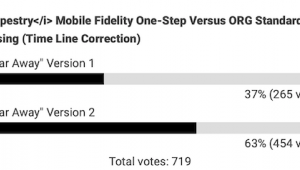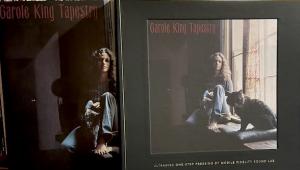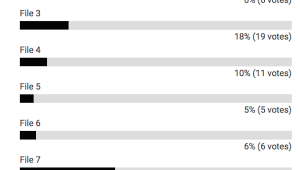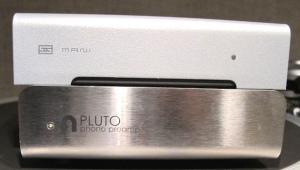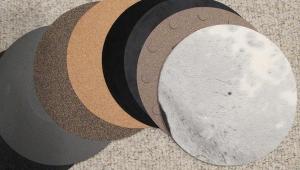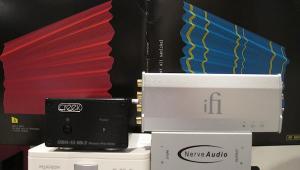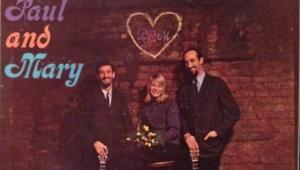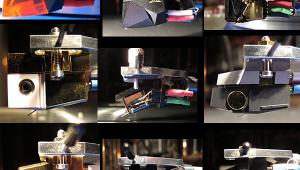... that don't exist on the other file! 10 seconds is enough to hear that :) 1014ReinerAP file sounds much better to me.
Primary tabs
Which "Scheherazade" is the "Better" Record?

Over the past few years a few audiophile/record collectors have played for me records they'd purchased, some at considerable expense, from Tom Port's Better Records, which advertises on this website.
The business model is to scour the world for used records and select the very best sounding for resale at what some would consider to be very high prices that some find outrageous. I don't. Going through dozens or more pressings of a given title to find the very best sounding is a time consuming process. You have to listen all the way through especially if you sell the records with a money back guaranty.
You could do likewise if you have the time, inclination and money but those with money it's easier to let someone else do the work and pay for it. Anyone who's sat down with a stack of say, Crosby, Still & Nash knows pressing quality and sonics are all over the map, with specific lacquer cuts and pressing plants producing the best sound—but not always. So while cynics will say they can buy clean copies all day for a few bucks of CS&N, getting a great sounding copy (beyond just "clean") takes perseverance and a great deal of knowledge. No doubt over the decades Port has been doing this he's gained plenty.
There's no controversy when you hear an "RL" Led Zeppelin II of course. That is most certainly a "better record" and worth whatever it costs to get one in great condition. On the other hand, a friend got a copy from "Better Records" of The Rolling Stones's Let It Bleed on the American London label that cost him plenty. In my opinion there are no good, not to mention better copies of that album on London records, which were all mastered and pressed in America. The only great copies of that one are on the British Decca label (in this case Londons and Deccas are way different!).
That said, though I believe the company's term "Hot Stamper" is a marketing ploy (like "Living Stereo", or "Living Presence") most of the "Better Records" records that I've heard have been sonically superior for whatever reason or reasons so it's no mystery the company has thrived and prospered over the decades its been in business even though, as some of you may know, Mr. Port and I have not always seen (6) "eye to eye" on everything.
After Analogplanet's enthusiastic review of Analogue Productions' Scheherazade (LSC-2446) "Living Stereo" reissue, Better Records contacted us with an offer and a challenge: they would send us a nearly top rated original "Hot Stamper" pressing for us to compare with the reissue.
The copy that arrived (some time ago, I'm sorry to admit), pressed at RCA's Indianapolis plant had an "N/A" rating for side one (lacquer 14S) and an A++/A+++ rating for side two. The problem with side one was immediately obvious before I even played it: visible "strings of pearls" throughout "The Story of the Kalendar Prince" indicating "non-fill" issues. Top rated side two (12S, first mother, first stamper [A1]) looked and sounded as advertised.
However, rather than me comparing the two records, why don't you do it? So here are two 90 second excerpts from side two. Admittedly a longer sample would be more useful but I think the excerpted section is sufficiently useful. The turntable was the Continuum Caliburn with Cobra arm. The cartridge was the .2mV Transfiguration Proteus—which is not a warm and soft sounding cartridge and the phono preamp was the Ypsilon VPS-100 with the MC16L step-up transformer. A/D conversion was via the Ayre QA9 at 96/24 resolution.
The cuts are not at the same level and I chose to not manipulate the files in any way to level-match so adjust as necessary. Vote for which you prefer and then comment as to why and which you think is which.
One thing I can tell you for sure: the reissue jacket is far superior to the original since Analogue Productions went to the trouble of getting the original artwork including a spectacular image of Fritz Reiner. But the sound? You decide!
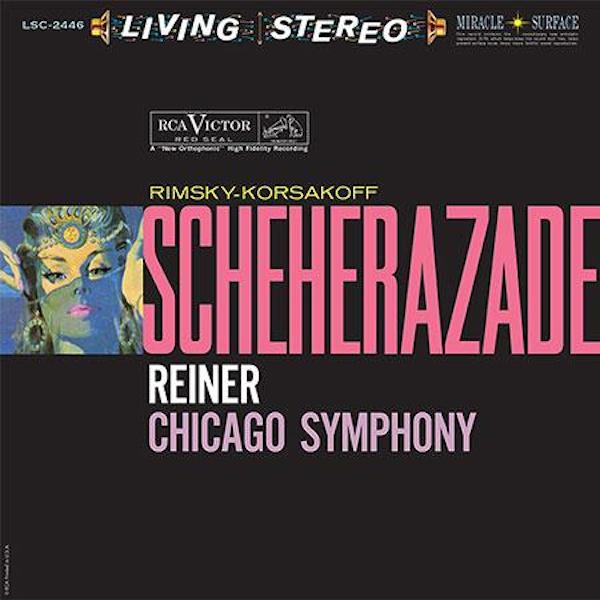
- Log in or register to post comments


Sample 1 has more depth. Sample 2 sounds more "in your face" like the mid-range was boosted, which takes away the atmospheric magic.
I'm guessing Sample 2 is the reissue, since it has the AP (Analogue Productions) initials in the sample title.

I guess this an "Emperors New Clothes" or a blind wine test moment, everyone is taking a back seat before they comment hehe.
I'll have a stab at it then and make a fool of myself.
My opinion when I close my eyes is that Sample 2 sounds like a recording whereas Sample 1 sounds more live and more real to me.
Because of the increased background noise, I will on a hunch say that Sample 1 is the Super Hot Stamper and Sample 2 is the AP reissue because it is quieter.
Both are good, but I'm leaning towards Sample 1 as sonically superior as the music filled me more, if that makes any sense....

Having never heard the piece of music given as a sample, I listened back and forth for some time to familiarize myself with the recording. As I did, I began to pick out the reasons for voting for File 2. File 1, which I am guessing is the original pressing, sounded fine at first, but after a few minutes, I couldn't help but hear a rumble during the quieter passages, smearing during more complicated, multi-instrument sections and the surface noise of the LP, though not prevalent probably due to the Caliburn pushing it back.
At the same time, I heard in File 2, a blacker background with less noise and no rumble, clear transient and decay and awesome separation of instruments during complicated sections, and what seemed to me, a brand new hunk of beautiful vinyl being played back better than I will ever hear it in my own home.
A confession, I don't pick through record bins looking for a certain pressing, nor would I begin to know how, unless I had a mental breakthrough and remembered an article from Mr. Fremer on just how to do such, but this brain isn't likely to recall anything such as that. Being from a small town in Michigan, which just lost its last independent new/used LP store( The wonderful Wyatt Earp's Records in Flint, MI, which could be trusted without hesitation for the best recommendations, not having to worry about getting home and finding grooves as wide as the Grand Canyon and prices that could not be beat. Miss you Doug-RIP and Al). There are, I believe, two stores that carry used vinyl in Flint. One is owned by a former local DJ from, i don't know, the early 60's-mid 80's, which I have been in twice. He is the kind of owner that likes to price his product as if it were graded Mint/Mint(Cover/Vinyl), though I have yet to find a single album in such condition and have even found "Record Mfd by BMG for 'insert label here'", which was probably free along with the other ten and sounds like shite, but is priced as if it has been professionally graded, and if pressed, he would probably tell you every record in his store is the best pressing that can be had. Ridiculous. The other is a chain of used LP's, comics, magazines, books, cd's, tapes( cassette and 8-Track!!!) Price gouging is not uncommon, and as you open the door, the smell of mildew and dust and, if it has a smell, I am about to be ripped off in here if I buy.
So, on a couple of recent trips to Chicago, my Son(17!!!) and I had a little time to check out some nice stores and load up on new and used vinyl, though, even in the Windy City, its not like you get to browse through 4 or 5 copies of the same record and try and figure out which is going to sound the best. Reckless Records, our favorite for current, new and old indie and alternative will play the LP for you before purchase, is priced fairly and has friendly, knowledgeable staff.
Down around the corner and down the steps, there is a Jazz and Blues LP/CD store(80%/20%) with a proprietor who really knows his stuff. I picked up a reissue of Thelonious Monk 'Paris 1969', Double LP, Gatefold with extensive liner notes on 180Gram Vinyl for $19.99. Before purchasing, I walked through the strode with the copy in my hands, stacked on top of a 1969 release of the same LPs(not 180Gram) retail of $29.99. Also in my sweaty palms was The Incredible Jimmy Smith feat. Kenny Burrell and Grady Tate, 'Organ Grinder Swing' on Verve, original 1965 recording, single LP Gatefold with VANGELDER proudly printed in the runoff for $7.99, a quick but thorough check of the vinyl made it a no brainer. How nice, I thought, it would go with Verve's Wynton Kelly Trio/Wes Montgomer's 'Smokin' at the Half Note', also from '65 i believe, also a single LP Gatefold with VANGELDER stamped, I had that at home already and it is a 'showoff' LP for the slightest Jazz fan who enters my home. I only hoped that my new purchases would sound close to 'Smokin', if so, i would be a happy man. I am a happy man. I only wish it wasn't 1:40 AM or I would cue one or all up and crank them, yea, headphones, Grado SR125's, or my very accurate, natural if slightly warm SOL on ear V10's, but, I should go to bed since I just dozed off here on the couch fro about an hour and a half.
Thanks For Reading my Rambling On, if you made it,
JeepLar

Felt like I understood the music better in file 2 via my headphone playback. File 1 didn't grab me as much.

I found sample one more, natural, laid back and smoother. File 2 seemed louder with great HF energy and was more up-front for lack of a better word. I think that I have the SACD of this at home which I will check and listen to when I get home from school. That is one of a number of SACDs I own from that RCA series which are great.

Adding some light to my previous comment, Sample 2 (I think is the reissue) to me sounds more refined/polished which is why I said it sounds like a recording, compared to Sample 1 which sounds raw to me and more real.
I have orded the AP reissue (havnt received it yet) and If it is Sample 2, I'm not complaining. Both are ok and both have their strengths and weaknesses.
I must admit, I did not listen to this on my full system as my amp is out of action so didn't get the full force.
Would love a few more comments from others.

Both sounded great, but two did sound a bit more Hi-Fi to me while 1 sounded a less etched. I am just listening at work, but that is what I hear. I look forward to the reveal!
Trey

For me File 1 has ambiance not present in file two. It sounds spacious, open and "live"; like the orchestra is there in front of you. File 2, even though it has a darker background ends up sounding more closed in to my ears. Further, the instrumental separation is better in File 1. An example is the trumpet puttering away underneath the woodwinds at 0:35 which is nice and audible in File 1 and a bit muffled in File 2.
Anyhow, I think the differences here are mainly in the mastering and not so much the pressing. Both pressings sound pretty good. File 1 has a touch more surface noise so I'm guessing it's the original.

File 1 is also about 2dB quieter then file 2. People using foobar 2K as their source can easily adjust for this using replaygain.
(right click on files->replay gain->scan per-file track gain. Make sure that replaygain is enabled in the playback options (source mode: track processing: apply gain))

File one sounds smoother and allows me to hear the inner clarity better. File 2 got a little loud (good dynamics) but a little too forward and brash. Good, but I would pick the lusher sounding file ONE if I had to choose.

Thank you for the two snippets - I am constantly swaying between originals and hi-q reissues - I really think they illustrate the differences I often hear - typically originals sound more ethereal, delicate and freer while re-issues have better, quieter vinyl, less distortion and a more solid etched picture but peversely constrained - I guess it is not a RIAA thing but something to with EQ, tape loss etc etc (wtf) Anyway my guess (and preference) was file 1 is the "original" but liking bits of 2 better. PS Does anyone think there is a different approach between US and UK/Europe mastering?

These blind tests are my fave of your posts, Mikey.
I picked File #1, because it did NOT sound more live. Having attended more symphony concerts than my wallet cares to remember, File #2 sounded thicker and more back of the hall. It's bass bloomed and overwhelmed other details. It was also louder.
File #1 had more of a front row or conductor's podium sound; wider, deeper, closer to instrumental details with a dryer bass. Once volume equalized, I'm sure that difference would be even more apparent.
Personally, I prefer stereo recordings to sound as if made from the conductor's podium. I want to be "in" the performance, not a distant witness. Mono, of course, tends to sound more back of the hall.

Sounds to me like the files are pretty close with #1 sounding light it has a brighter frequency balance, and maybe a wider presentation. Who knows if the frequency differences are down to differences between working from the new master vs. a 60-year-old master, different mastering and cutting lathe or whatever; but to me file #2 has less surface noise and extraneous non-musical stuff going on, which to me makes it the better record.

Ok Michael, we give up. Please post which was which and what "your" thoughts were as you listened to both in your room. Most of us are only listening with headphones to these snippets. That's nothing like listening to each lp on your system. What was the cost of the "hot stamper?" I hear a difference.

Why on earth would he send you a copy with obvious flaws on one side? If a serious collector like him doesn't even own a copy with 2 good sounding sides, that alone validates the AP reissue.

... describing lack of energy, inferior transient response, and EQ that is slightly rolled off at the top, as sounding more "spacious" and "life like", is not the best way to approach this. It does reflect a very personal preference/taste but when it comes to audio fidelity it makes little sense...
Better transients and full range sound presentation is better and more "real" in the sense that it represents more faithfully what was indeed recorded.
When this is not taken as a fact, then I suppose some listeners are mostly fondly remembering how the original LP sounded, and not how the actual recording session / performance sounded.
The "hot stamper" sampled here is not bad, sure, but it's not hot at all (and I hope it's not expensive, specially being useful only on a single side, which is a bit ridiculous), actually it's "cold" sounding when compared to the AP reissue that is better in every conceivable way if accurate sound reproduction and being faithful to the original recording/performance is still the criteria for a good music production on any format.

First off, you don't know which is which. But yes, I too can guess that the harder sounding version is the AP version. Which is better is very subjective. For me, I listen to the loud passages. How do those come through. Do all the instruments seem to come together, thereby making it hard to determine and hear each on its own? Do the highs not seem natural during the loud passages? Therefore, for me and my ears, File 1 gave me dynamics without congestion. Clarity without hardness. But I find it hard to understand how you can determine that the AP pressing is more "faithful" to the original recording unless you have access to the master tapes.

The AP does not sound harder, it simply has more information... Orchestras sound like that in real life. I've never heard that type of performance, live, sounding soft and muted... I know that the AP is a better representation of the performance based on experience listening to such performances and knowing what instruments, concert halls, session recordings, studios, and so on, sound like. Sure I could be wrong, just like every single person commenting about this here, but this is my opinion, I don't pretend to make it a fact or any kind of science, I'm just sharing my thoughts, some people give it some credit, some don't, I'm fine with that, my path is my own :)
It is also very easy, for me, to recognize mastering flaws resulting from format limitations, or related to the sources used, or obvious bad EQ choices, compression... you can hear that, when it's there... and when it's not there :) For me, clearly, this AP reissue is mastered in a way that is not as limited and "altered" as the original. Just my opinion :)
In general I think there are many people in the audio world that confuse their personal preferences with what high fidelity should be. Sure, it all comes down to what we like, but it is not impossible to learn and be aware of what is going on behind "sound", and what we don't like is not always the technically inferior production.

At the risk of multiple comments ( t though I had already posted), listening over a desktop computer, the differences are pronounced. I suspect File 1 is the RCA and 2 is the re-do. If that is correct, it is consistent with what I find on a lot of good remasters- more detail, better bass, but lacking a certain coherence or natural quality that the original conveys. This, over a crappy computer and 40 dollar satellite speakers. If my take on all this is right, why are the remasters more 'audiophile' in detail but a little bright sounding, generally, compared to the originals? Is it modern mastering, compensating for losses from old tape, or a choice based on more modern sensibilities? I know I'm painting with a wide brush, I've heard differences in the same mastering engineer's remasters for different labels of the same track that are not as pronounced, which leads me to believe there are choices being made here. I have an old white dog of this record, but no new re-do's.
Best,
Bill Hart

You get ultimate coherence from cheap car audio, listening to radio FM and driving with windows open... :)
That is not high fidelity. That feeling that well done remasters "lacking a certain coherence or natural quality that the original conveys" is the immediate and automatic result of more information, more resolution, better transients, more frequency extension top and bottom...
The less of everything you have (technically), the more "coherent", less intrusive, softer and easier it will sound. We might even call it natural, or warmer, though it isn't natural at all...
One can argue that for the most satisfying domestic (home) music reproduction, one does not need or want the ultimate technical accuracy or fidelity... heck, some people say that's why some listeners prefer vinyl and all its flaws (I disagree with that), but let's not confuse higher fidelity with loss of coherence or "natural" sound. It's the other way around... ;)

more information and accuracy is 'better' in theory, if it is a question of which sounds more like music and less like hi-fi, I'm not so sure. But, that's what makes this interesting, no?

I've heard that reason before with why I found CDs to sound harsh. "Oh, that's not harshness, that's added detail, more resolution, better transients, greater top to bottom frequency extension." In the end, although CD was "technically" superior on paper, I found it to be non-musical in comparison with vinyl. While I realize that this is not a CD vs vinyl debate, your reasons why we "should" determine File 2 to be the winner is similar in argument to why we "should" have all determined that CD was superior to vinyl. In the end, it really comes down to what is perceived as "musical" to a listener. And I do agree that that can be very subjective based on ears, tastes, system, etc. A warm based system would lead one to conclude that File 2 is more musical. A highly detailed system would lead some listeners to conclude File 1 is superior. Bottom line is that if a reissue does indeed have greater resolution, that in itself may take away the "magic" that I was experiencing with the original pressing. It's the magic that I seek! Isn't that why some fantastic studio monitor speakers do not sell well in the home market. They reproduce every last little bit of detail for a highly accurate playback in the studio, but man, in my living room, that same speaker doesn't convey the musical impact that I seek.

The main difference is that when that was said about CD's it was a lie, there was no "added detail, more resolution, better transients, greater top to bottom frequency extension" hehehehe it was not true! When I say that about good quality remasters reissued on proper vinyl, it is true and a fact. Similar argument but very very very different context :) I can't be to blame for the "CD Perfect Sound Forever" lies now, can I? ;) All the rest is just personal taste... no use to debate if one prefers the sound with more strawberry jelly or less strawberry jelly.

I believe I can agree with what you said, with some further thoughts. If I understand you correctly with this post and your other posts, the newer technology now available to the mastering engineer allows greater detail to be transferred from master tapes to final vinyl pressings. That greater detail, resolution, etc., can now be unveiled to the listener, which may result in a sonic performance that differs from the original vinyl, but is more representative of what was on the master tape. Therefore, pressings from the golden age of vinyl which have been sought after for their sumptuous sound, were really pressings that were not representative of the master tape, but due to limitations of the time period, came off sounding musical instead of accurate.

Yes, I agree with that... I wouldn't say it is a "rule", but it does seem to happen often. We usually tend to forget that mastering is the art of "squeezing" the source into the usually much more limited end consumer format, the idea is to make it usable for the consumers, and this takes into account not just the format itself but also all the limitations of the "average" consumer playback system, consumer habits, generational and country specific tastes and trends... a lot of things... that is what mastering is all about, if everybody had a professional studio grade playback system at home, there would be no mastering as we know it, just copies of the final mix for distribution. Much has changed from the 50's / 60's until today... back then the gap between source (professional) and consumer sound was HUGE, but today it's a very different story, more so if we're talking about a product specifically targeted to the audiophile niche market (as is the case with Analogue Productions). Mastering the same content today is something else entirely... It is certainly interesting that the original mastering has that "musical" quality to it that we all like because it throws less intrusive sounds at our ears, and that's perfectly ok, it's expected that we react like that, it's a natural reaction. But that is not what I would expect from a great remaster done today, I want the "full range" performance, as much exposed as it can be from the original tape :)

I think there is a channel balance problem in your two samples: if I compare the two wav files to all three editions of Reiner's recording on spotify, I find your transfer to be panned hard to the right channel:
in the spotify versions the cymbals are way to the left, not to the right like in your samples. Also the first violins are placed left of center on spotify, like they usually are in a concert hall, while they are clearly to the right on your samples.

